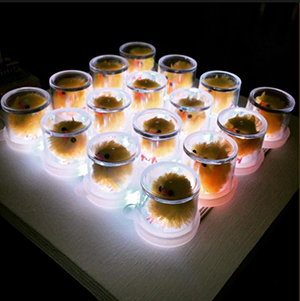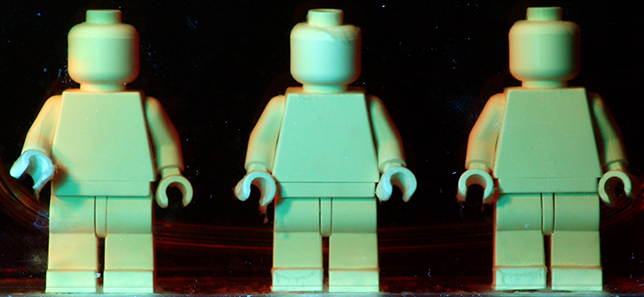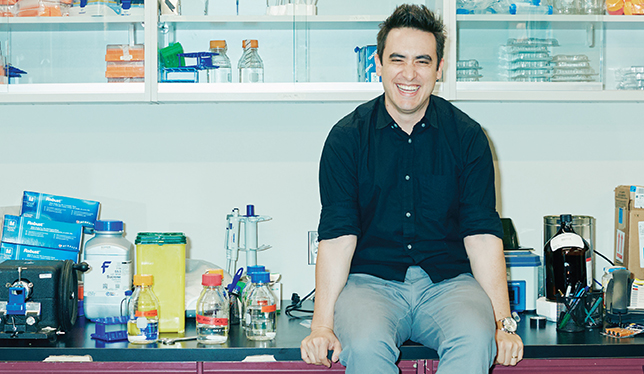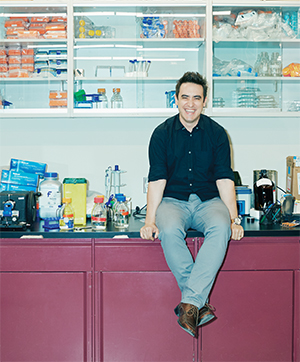The boxes of tiny, bright-yellow toy chicks from the Dollar Store sit in boxes on the table in Andrew Pelling’s temporary office buried deep in the Minto Sports Complex at the University of Ottawa. They are remnants of the “Chixel Array,” a colourful display combining the chicks with flashing LED lights and little transparent plastic helmets to diffuse the light. The Chixel Array has no practical purpose – just more brainstorming whimsy from Dr. Pelling, professor of physics and biology at U of Ottawa. “I don’t know where this goes, but for me this is how I keep my own mind creative,” says Dr. Pelling.

In many ways, the Chixel Array personifies the questing and inquisitive nature of Dr. Pelling – a man who co-authored a paper detailing the beating heart of a Monarch butterfly as it emerged from the chrysalis and who has gained fame for using an apple’s cellulose structure as a matrix on which to grow a lifelike human ear.
While Dr. Pelling himself was hard to find for an interview earlier this year (because his regular office had been displaced during the construction of the university’s new STEM building), he was by no means anonymous on campus. Around the corner from his temporary office, a large billboard displays his profile – the 38-year-old professor is one of the faculty featured in the university’s fundraising campaign with the theme “Defy the Conventional.” The billboard states in part:
“(Andrew) Pelling is a rising international star whose unorthodox approach to biology is inspired by the hours he spent as a teenager dismantling stereos and CD players and creating something new from the parts. Now he is doing the same with biological systems – including fruits, vegetables and flowers.”
Dr. Pelling is often described as a biohacker, meaning someone who uses the tools of molecular biology and genetic engineering to modify a plant or animal cell or organism. He often uses cheap and readily available materials, another feature of biohacking. His lab, the Pelling Laboratory for Biophysical Manipulation, brings together scientists, engineers and artists who want to create living objects that don’t exist in nature. Dr. Pelling holds the Canada Research Chair in Experimental Cell Mechanics, investigating how cells respond to physical forces.
In addition, he co-founded a company and a street-level lab, both related to his research. In his many roles, he is relied upon for his ease at explaining complex concepts to people outside the field. In person, he has an infectious good humour and unfettered curiosity about everything around him.
Dr. Pelling’s route to rock-star status as a scientist who defies convention while not yet 40 spans a few countries as well as the worlds of art and science. Born in Hitchin, U.K., outside London, he moved with his family to the suburbs north of Toronto at a young age. The first school he attended was an arts school. “I spent all my days painting, dancing and singing,” he says.
Somewhat paradoxically, it was during elementary school that he discovered a love for math and science. In high school, though, he failed chemistry and his teacher “told me I should never pursue chemistry. To me that’s a challenge.”
His love of chemistry was reignited at the University of Toronto in his very first lecture as an undergraduate. “The prof opens by saying the heart of any good chemist is someone who wants to make things burn and blow things up.” That, he says, confirmed that chemistry was for him. In the same period, he was developing an interest in “the curiosity of discovering things.”
Armed with an undergraduate degree in biological chemistry, he moved to the University of California, Los Angeles in 2001, completing a PhD in physical chemistry in 2005. At UCLA, he says, the “arts came back into my life.”
UCLA’s Art|Sci Center, a collaborative space for media arts and the sciences, engrossed Dr. Pelling: “I was working daily side by side with artists, doing science experiments as well as developing arts exhibitions.” For him, that experience validated the need for diverse perspectives and “how you get the best and most creative ideas when you get the most creative people together.”
Victoria Vesna, founder and director of the Art|Sci Center and a professor in the department of design and media arts, recalls that as a PhD student Dr. Pelling contributed to a number of artistic products, including a project with media artist Anne Niemitz that ultimately produced the concert-installation show, The dark side of the cell. The show featured cellular sound that allowed humans to hear the oscillations of cells.
“He’s very open, very personable. He can translate complex ideas in ways that people can understand,” says Dr. Vesna. She believes that these qualities likely have contributed to his success.
Postdoctoral work took Dr. Pelling to University College London, where he was a senior research fellow at the London Centre for Nanotechnology from 2005 to 2008. It was here that he discovered the frustrations of being a scientist who loves pure discovery in a world that expects results.
“Throughout my scientific career,” he says, “I’d make a discovery in the lab and I’d be all excited and tell my colleagues, and they’d look at me with this blank expression and say, ‘So what’s the application?’ It sent me a very clear signal that people only valued my research if there was a dollar sign or some bogus application at the end of it.”
He recognized that he could become resentful of this attitude or he could set out to make his own way in the academic world by running an experiment with “the most creative people in any discipline that I can find and I create the conditions to foster their curiosity. My hypothesis is we would still make discoveries.”
In 2008, he applied for a position in the physics department at U of Ottawa after the application deadline had passed and was hired. The same year, he received his Tier 2 Canada Research Chair (renewed in 2013) and founded his lab for biophysical manipulation. It is here that Dr. Pelling is fulfilling his experiment of bringing creative people together to foster curiosity and, in the process, make discoveries. “Basically I have a five-year runway to do this,” he says, “before I have to apply for tenure.”
The lab is described on its website as “an openly curious and exploratory space where scientists, engineers and artists work in close quarters” and create “living, functional, biological objects that do not exist in nature.” These include, as an Ottawa Citizen story reported last year, growing light-emitting skin – made from human cells modified with a jellyfish gene – on LEGO mini-figures.

In an unusual aside in his biography on the TEDTalks website, Dr. Pelling notes that he is proficient with the ukulele. In fact, he says he plays many musical instruments.
He is married to Olivia Pelling, a second-generation luthier (maker of stringed instruments) whom he met when they both were undergrads at U of T. She owns a company in Ottawa that makes and repairs violins and similar instruments.
While they normally work separately, there is at least one project in which the couple collaborated. In 2012, they integrated an Arduino (a platform used to create interactive electronic objects) with a violin handmade by Olivia. When a violinist played the instrument, the Arduino sensed the frequencies being created and linked to the songs of seven endangered Canadian birds with similar frequencies.
Some articles also give Olivia a bit role in assisting Dr. Pelling’s most famous experiment with the apple and the ear, noting that it was she who initially carved the apples into the shape of ears.
Though Dr. Pelling now has all the trappings of an established academic, he sees himself more as a disruptive influence intent on reforming the system from within. “I think academia is ripe for disruption,” he says. “It’s an old, old model and I’m not sure it’s relevant in today’s world anymore.”
While he says that universities are fantastic places for “unfettered and basic research,” he nonetheless believes the academic system is broken. “Students are not interested in it. I’m barely interested or excited by the current model.” He questions the utility of a model based on the need to publish in order to thrive, especially if the research is not read or cannot be understood by people on the street.
His own initiatives “challenge academia on purpose,” he says. “Everything I do is an experiment. There is always a hypothesis and a method. That goes for my start-up company. That goes for my public initiatives.”
André Longtin, chair of the physics department at U of Ottawa and the person who hired Dr. Pelling, calls him “a good citizen” within the university community – a faculty member who delivers on what he envisions, who collaborates with colleagues on their projects while working on his own, and who attracts more students and colleagues to the department.
Being a disruptor is part of Dr. Pelling’s role, says Dr. Longtin. As a biohacker, Dr. Pelling and others “are trying to help the body repair itself, in better and fancier ways, to grow human cells.” This novel approach – and especially the apple-ear project, which has attracted more than one million views since Dr. Pelling explained it in a 2016 TEDTalk – is something people beyond the science world can relate to.
Dr. Pelling says that in his work he “purposely set out to do nothing useful – until we accidentally started doing useful things and I couldn’t say that anymore.”
One of the most potentially useful discoveries he has made with his team is the concept of using cellulose derived from plants to grow human cells. Using highly evolved plant tissue, they construct 3D scaffolds to promote cell infiltration, cell growth, angiogenesis and tissue repair and reconstruction.
His best-known experiment used the cellulose structure from an apple to grow cartilage and specifically a human ear. As they describe in a 2015 article (PDF), “the objects prepared in our lab are a hybrid between plant and animal (in the spirit of the movie Little Shop of Horrors). The samples were created without the use of genetic engineering; instead, researchers relied on standard cell culture techniques.”
While the people in Dr. Pelling’s lab are not the only researchers doing this type of work, their focus on using inexpensive biomaterials to produce potential “replacement parts” for humans is somewhat unique, as is Dr. Pelling’s ability to describe his work in an entertaining way that the public can understand. Indeed, this year he was chosen by TED as one of its 10 senior fellows from more than 400 fellows worldwide.
One of his other roles is chief scientific officer for Spiderwort, a company he co-founded with two others to market this and other discoveries from his laboratory. Now, four years after he began growing human tissue on vegetable matter, Dr. Pelling and Spiderwort are working with surgeons at the Ottawa Hospital, and will soon start clinical trials to test the safety and compatibility of biomaterials when used in humans.
Dr. Pelling is a huge asset in the corporate world because he explains complex ideas in simple words, both in writing and speaking, according to Charles Cuerrier, chief executive and a co-founder of Spiderwort. He says, “You always need someone like him who can easily represent the company, and to simplify things.” Dr. Cuerrier, who has known Dr. Pelling for a decade and is a postdoc fellow in his lab, also praises Dr. Pelling for making the work important and exciting to the people working alongside him.
While Dr. Pelling may challenge the academic model, he still likes to teach. He especially enjoys reawakening curiosity in his students. “I think in our society we have devalued curiosity,” he says. “I’m interested in curious creative minds – people who truly believe they are going to change the world, like it or not. Those are the people I want around me.”
Maryam Tarar took Dr. Pelling’s second-year biophysics course when she was considering going into medicine. She enjoyed the course so much she switched to the BSc program, majoring in chemistry with a minor in physics. While the biophysics course material was challenging, Dr. Pelling’s approach was to “focus on understanding the physics that go on behind all the biology and processes,” says Ms. Tarar. “He encourages you to go out and read and stay updated on what’s going on in the field of physics.”
Other students concur. “His classes are not about what you can regurgitate in exams,” says Daniel Modulevsky, a PhD candidate in biology and the third co-founder and chief biomaterials officer with Spiderwort. “It’s more about applying what you’ve learned from him in the real world.”
In April of this year, Dr. Pelling launched a new venture, pHacktory (pronounced “factory”), a collective that brings science to the streets in a way that makes you say, “I wonder what would happen if.” It was “designed purposively to challenge current norms and models in academia to see if there are better ways of going about things,” says Dr. Pelling.
The concept arose from a presentation he gave to a community group in Ottawa in 2015. While trying to provoke a discussion of security concerns around biohacking, he recalls, “at the end of the talk I sort of blurted out ‘wouldn’t it be great to put my lab on the street.’”
He was overwhelmed by the response to the talk, with everyone from primary school teachers to the CEOs of major corporations calling to encourage him to do exactly what he had suggested. “When in your life do you throw out an idea and everybody wants to see it happen? It’s so rare.”
The idea is to take the most “audacious projects we can find that are curiosity driven” in any field and run them for 100 days to see if they can achieve proof of concept. By late May, about 40 applications were being considered. “We are looking for the special ideas that are probably not going to work,” says Dr. Pelling, “but if they did, it would be awesome.” He notes that the approach is the antithesis of how granting programs usually function.
He reiterates that while pHacktory will support far-fetched ideas and reject those that are “too safe,” nonetheless the projects that are accepted will be scientifically based. As a result of the attention given to pHacktory, Dr. Pelling says he created a business model to support the approach which can be characterized as “risk as a service.” Large companies are approaching him with offers to test ideas that they themselves find too risky.
Where will Dr. Pelling’s curiosity take him next? Mr. Modulevsky, his doctoral student, speculates that Dr. Pelling’s most lasting contribution could be “to take that huge risk as an untenured prof” to go after something that’s “really outside the dogma of current science.”
Dr. Pelling himself has no idea what he will be doing in 10 years, but says he wants it to be something he cannot even visualize today.
With notes from Marla Fletcher.

